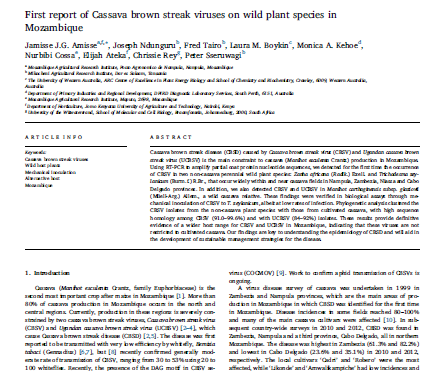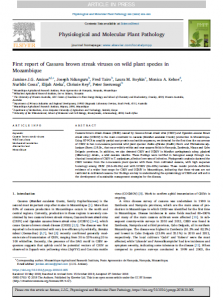Cassava brown streak disease (CBSD) caused by Cassava brown streak virus (CBSV) and Ugandan cassava brown streak virus (UCBSV) is the main constraint to cassava (Manihot esculenta Crantz) production in Mozambique. Using RT-PCR to amplify partial coat protein nucleotide sequences, we detected for the first time the occurrence of CBSV in two non-cassava perennial wild plant species: Zanha africana (Radlk.) Exell. and Trichodesma zeylanicum (Burm.f.) R.Br., that occur widely within and near cassava fields in Nampula, Zambezia, Niassa and Cabo Delgado provinces. In addition, we also detected CBSV and UCBSV in Manihot carthaginensis subsp. glaziovii (Müell-Arg.) Allem., a wild cassava relative. These findings were verified in biological assays through mechanical inoculation of CBSV to T. zeylanicum, albeit at low rates of infection. Phylogenetic analysis clustered the CBSV isolates from the non-cassava plant species with those from cultivated cassava, with high sequence homology among CBSV (91.0–99.6%) and with UCBSV (84–92%) isolates. These results provide definitive evidence of a wider host range for CBSV and UCBSV in Mozambique, indicating that these viruses are not restricted to cultivated cassava. Our findings are key to understanding the epidemiology of CBSD and will aid in the development of sustainable management strategies for the disease.
Region: Mozambique
Date published:
2018
Published by:
Physiological and Molecular Plant Pathology
Type of resource:
Journal article
Resource topic:
Cassava
Project/Programme: Cassava Diagnostics Project
Pest/Disease: Cassava brown streak virus, Cassava mosaic virus
Pages:
8
File type:
External link (2,312 KB)




